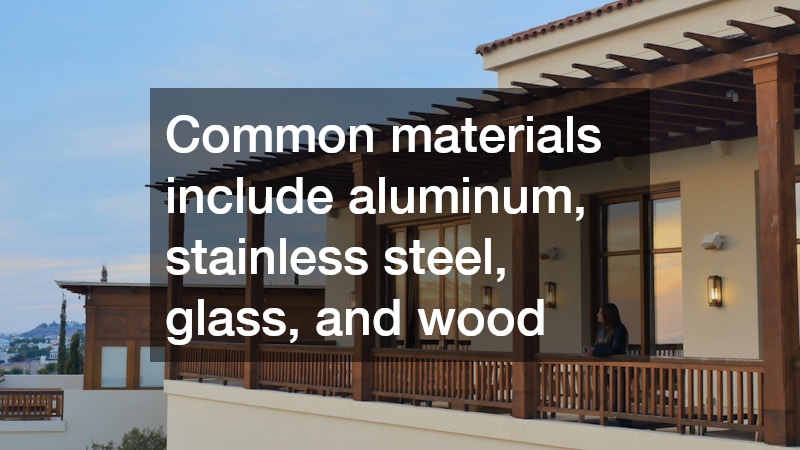Balcony railings are often seen as purely functional features, but in reality, they play a pivotal role in shaping a property’s safety and style. With the right design and installation, railings can do much more than prevent accidents—they can transform the character of your outdoor space, enhance curb appeal, and even boost property value. That’s where professional balcony railing services come in, offering solutions that seamlessly blend protection with design.
Today’s railing options go far beyond the basics, with materials, finishes, and styles that can complement any architectural theme. Whether you’re drawn to sleek glass panels that open up your view or intricate metalwork that adds timeless elegance, the right railing can elevate your space in unexpected ways.
At the same time, quality balcony railing services make sure that every design meets strict safety standards, so you never have to choose between beauty and security.
Blending Functionality with Aesthetic Appeal
When designing and implementing balcony railings, the balance between functionality and aesthetic appeal is paramount. Not only do railings serve as a safety feature, preventing falls and injuries, but they are also significant visual elements of a building’s exterior. Designers and architects work diligently to ensure that railings complement the overall architectural style, enhancing the building’s visual appeal without compromising on safety.
Modern balcony railing services offer a myriad of design options that cater to both contemporary and traditional aesthetics. From minimalist glass panels that offer an unobstructed view to ornately designed wrought iron railings that evoke a sense of elegance and history, there’s a solution that aligns with every design intention. Effective service providers are skilled in advising clients on the best materials and styles to enhance their building’s character without sacrificing functional integrity. The challenge lies in aligning these aesthetic qualities with stringent safety requirements. Effective balcony railing installations transcend mere compliance with local building codes; they elevate the design language of the entire facade.
Exploring Popular Materials for Modern Railings
The choice of materials for balcony railings significantly influences their look and functional performance. Common materials include aluminum, stainless steel, glass, and wood, each offering distinct advantages and varying aesthetic impacts. Aluminum railings, for example, are lightweight, durable, and require minimal maintenance. They are also available in a variety of finishes to match any building style.
Glass, while offering a sleek, modern look that maximizes visibility and light, must be tempered and laminated for safety purposes, making sure it can withstand heavy impacts without breaking dangerously. Stainless steel is celebrated for its strength and resistance to corrosion, ideal for balconies exposed to harsh weather conditions. Each material must be chosen not only for its physical properties but for how well it executes the design vision of a space. Wooden railings, though less common in urban settings, provide a natural, classic appearance that can be particularly striking in the right contexts. However, they require more maintenance than metal or glass options.
How Balcony Railing Services Enhance Safety Standards
The primary function of balcony railings is to protect people from falling, making safety the most crucial aspect of their design and installation. Experts can confirm that installations meet or exceed local safety regulations and standards. These standards are continually updated to adapt to new research and technology, indicating an evolving commitment to safety.
Professional railing services conduct thorough assessments of every aspect of railing installation, from the integrity of the materials to the strength and stability of the mounting. This meticulous attention to detail ensures that each railing not only looks good but is structurally sound and capable of withstanding both everyday use and extreme conditions. By specializing in balcony railings, dedicated professionals keep abreast of the latest safety innovations and features, such as integrated lighting or railings designed specifically for accessibility.
Custom Designs That Elevate Your Outdoor Living Experience
Custom-designed balcony railings are more than just safety barriers; they enhance and personalize the outdoor living experience. By working with skilled railing services, homeowners and developers can implement designs that reflect unique architectural visions and functional needs. Whether the goal is to maximize views with ultra-clear glass or create a patterned ironwork that speaks to historical inspirations, custom railings can bring these visions to life.
The design process includes consideration of the building’s overall identity and the occupants’ lifestyle needs. For instance, a balcony in a high-wind area may benefit from specially designed railings that reduce wind impact while maintaining a high degree of transparency. Similarly, railings for a family-oriented apartment complex should be designed to be both child-safe and aesthetically pleasing. Incorporating custom elements such as personalized color matches, varying rail heights, and integrated lighting solutions allows for a level of detail that significantly boosts the aesthetic and functional value of any property.
Balcony railing services may seem like a small detail in the grand scheme of home improvement, but their impact on both safety and style is undeniable. By carefully selecting the right materials, designs, and professional installers, your balcony won’t only be secure, but also a standout feature of your property.
Whether your goal is to create a modern, open look with glass railings or to capture timeless charm with wrought iron, investing in professional balcony railing services is an upgrade that pays off in both peace of mind and aesthetic value. A well-designed railing does more than meet safety codes—it elevates your outdoor living experience and enhances the overall appeal of your home.

